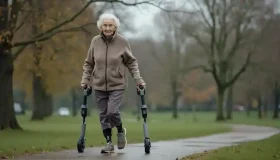Are you worried about an older loved one feeling down? Pet therapy programs offer a unique way to fight senior depression. These programs bring animals into seniors’ lives to boost mood and well-being.
You’ll learn how furry friends can help older adults feel happier and more connected. Get ready to discover the power of pet therapy for seniors.
Key Takeaways
- Pet therapy programs help seniors fight depression by bringing animals into their lives, boosting mood and social connections.
- Interacting with therapy animals for just 15 minutes can lower blood pressure by 10% and reduce feelings of loneliness in older adults.
- Dogs and cats are the most common therapy animals, with 65% of U.S. households owning at least one pet.
- Successful pet therapy programs require proper training, certification, and health protocols for both animals and handlers.
- These programs improve seniors’ mental and physical health, reducing healthcare costs and enhancing overall quality of life.
Psychological and Social Benefits of Pet Therapy for Seniors

Pet therapy offers seniors a powerful way to boost their mental health. It can help reduce feelings of loneliness and increase social connections.
Alleviation of Depression
Pet therapy offers a powerful tool to combat depression in seniors. You might find comfort in the presence of a furry friend, evoking happy memories and boosting your mood. Research indicates that petting a dog for just 15 minutes can lower your blood pressure by 10%.
This simple act not only soothes your nerves but also enhances your overall well-being.
For those living with dementia, animal-assisted therapy provides remarkable benefits. You may notice reduced agitation and improved social skills when interacting with therapy animals.
These gentle creatures offer unconditional love, helping to ease feelings of loneliness and sadness. With 65% of U.S. households owning at least one pet, many seniors find solace in the companionship of animals, leading to better emotional health and a higher quality of life.
Enhanced Social Interaction
Pet therapy doesn’t just lift your mood; it also boosts your social life. As you interact with furry friends, you’ll find yourself chatting more with others. These animal companions act as ice-breakers, sparking conversations and creating bonds between people.
You’ll notice increased social interaction during pet therapy sessions. Seniors often gather around therapy animals, sharing stories and experiences. This group setting encourages friendships and a sense of community.
Even dementia patients show improved social skills when interacting with therapy pets. The presence of animals creates a relaxed atmosphere, making it easier for you to connect with others and build meaningful relationships.
Types of Animals Commonly Used in Pet Therapy
Pet therapy programs use different animals to help seniors. Dogs and cats are the most common, but other animals can also bring comfort and joy.
Dogs
Dogs play a vital role in pet therapy for seniors. These furry friends bring joy and comfort to older adults, especially those feeling lonely or isolated. Studies show that spending time with dogs can boost social behaviors and reduce agitation in elderly individuals.
You’ll find that petting a dog for just 15 minutes can lower your blood pressure by 10%. This simple act offers both physical and emotional benefits.
Many U.S. households already enjoy the company of pets, with 65% owning at least one. For seniors without pets at home, therapy dogs offer a chance to experience these benefits. These trained animals visit nursing homes and care facilities, providing companionship and encouraging social interaction.
Their presence can lift spirits, ease stress, and create a sense of purpose for older adults.
Cats
Cats offer unique benefits in pet therapy programs for seniors. These feline friends provide comfort and emotional support, boosting mental health and social interaction. You’ll find cats can ease loneliness and reduce stress in assisted living and nursing homes.
Their presence often leads to lower healthcare costs for older adults due to improved overall well-being.
Pet therapy with cats shows great success in senior communities. These programs help alleviate depression and promote a sense of purpose. You might notice positive changes in mood and behavior among participants.
Cats’ gentle nature and low-maintenance care make them ideal companions for seniors with limited mobility or energy.
Implementing Successful Pet Therapy Programs
Pet therapy programs need careful planning and trained animals. You must follow specific rules to set up a safe and effective program.
Training and Certification Requirements
Pet therapy programs need proper training and certification. These requirements ensure the safety and effectiveness of the program for seniors.
- Animal Selection: Choose animals at least one year old. They must be friendly, obedient, and well-mannered. Full vaccination is a must for all therapy animals.
- Handler Training: Learn how to interact with animals in a therapeutic setting. This includes understanding animal behavior and stress signals. You’ll also gain skills in managing seniors’ interactions with the animals.
- Health and Safety Protocols: Master the steps to maintain a clean, safe environment. This covers proper hand hygiene and animal grooming standards. You’ll learn how to prevent the spread of germs between seniors and animals.
- Senior Care Knowledge: Gain insight into common health issues affecting older adults. This helps you tailor the therapy to each senior’s needs. You’ll learn how to spot signs of distress in both seniors and animals.
- Certification Process: Complete a recognized pet therapy certification program. These programs often include both classroom and hands-on training. You’ll need to pass a final exam to earn your certification.
- Ongoing Education: Stay up-to-date with the latest pet therapy practices. Attend workshops and seminars to improve your skills. This ensures you provide the best care possible to seniors.
- Liability Insurance: Obtain proper insurance coverage for your pet therapy work. This protects you, the seniors, and the animals in case of accidents. Many facilities require proof of insurance before allowing pet therapy sessions.
- Facility-Specific Training: Learn the rules and procedures of each care facility you visit. This includes understanding visitation policies and emergency protocols. You’ll need to adapt your approach to fit each unique setting.
Conclusion
Pet therapy programs offer a powerful way to fight senior depression. You can see real changes in seniors who spend time with furry friends. These programs boost mood, cut stress, and help seniors connect with others.
They also improve physical health by lowering blood pressure and heart rate. With trained animals and caring staff, pet therapy brings joy and healing to older adults’ lives.
FAQs
1. How does pet therapy help seniors combat depression?
Pet therapy programs use companion animals to boost emotional and physical well-being in the elderly. These programs can reduce depressive symptoms, lower blood pressure, and improve cardiovascular health. The bond between seniors and animals often leads to decreased levels of stress and a stronger sense of belonging.
2. What types of animals are used in pet therapy for seniors?
While dogs are common, other animals like cats, guinea pigs, and even birds can be part of animal-assisted therapy. The choice depends on the senior’s preferences and the goals of the therapy program. Different animals can offer unique benefits for mental and physical health.
3. Can pet therapy help with other health issues besides depression?
Yes, pet therapy can aid with various health problems. It may help manage chronic illnesses, reduce symptoms of PTSD, and support those with autism spectrum disorders. The physical activity involved in caring for pets can also improve overall fitness and heart health.
4. How does pet therapy work in long-term care facilities?
In long-term care settings, therapy animals visit regularly. Residents can interact with the animals through petting, playing, or simply being in their presence. This interaction can break social isolation, provide emotional support, and add joy to the daily routine of seniors in care.
5. Are there risks associated with pet therapy for seniors?
While pet therapy is generally safe, some risks exist. These may include allergies, potential injuries from animal handling, or the emotional impact if an animal passes away. However, with proper oversight from caregivers and health services, these risks can be managed effectively.
6. How can families incorporate pet therapy at home for aging relatives?
Families can consider pet adoption or arrange regular visits with therapy animals. They should choose pets that match the senior’s abilities and living situation. Even small interactions like stroking a cat or walking a dog can provide physical and psychological benefits. It’s important to consult with mental health care professionals to ensure the best approach for the individual’s needs.
References
- https://www.neuroscigroup.us/articles/ADA-10-194.php
- https://www.ncbi.nlm.nih.gov/pmc/articles/PMC4248608/
- https://www.ncbi.nlm.nih.gov/pmc/articles/PMC6826684/
- https://www.rosewood-nursing.com/post/benefits-of-pet-therapy-for-seniors
- https://www.cjcareconsulting.com/the-healing-power-of-pet-therapy-for-seniors-a-furry-companions-impact/





